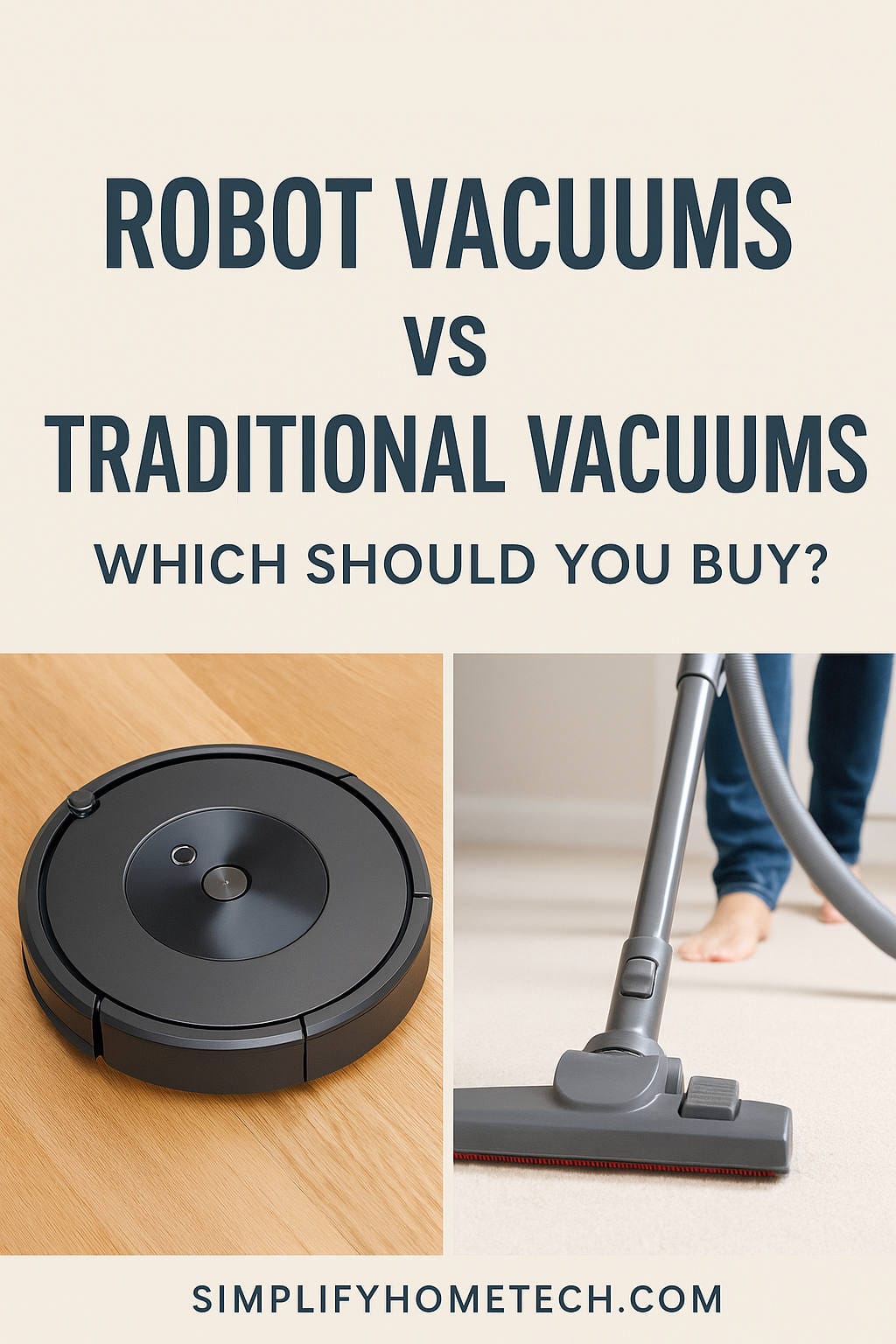Vacuum cleaners have long been essential for keeping our homes tidy and dust-free. But with the rise of smart home technology, robot vacuums have emerged as a futuristic alternative to traditional vacuum cleaners. Now, homeowners face a crucial question: should you go for a smart, automated robot vacuum or stick with a tried-and-true traditional vacuum?
This guide will dive deep into both types, examining their strengths, weaknesses, ideal use cases, and long-term value. Whether you’re a busy parent, a tech-savvy minimalist, or someone who prioritizes powerful performance, this post will help you choose the vacuum that best fits your lifestyle.
What Are Robot Vacuums?
Robot vacuums are compact, disc-shaped cleaning machines that clean your floors automatically. These devices use sensors, cameras, and artificial intelligence to navigate through your space, clean designated areas, and return to their charging stations when finished.
Common Features:
- Autonomous cleaning and self-docking
- Smart sensors for obstacle detection
- App control and voice assistant integration
- Scheduled cleaning options
- Slim design for low-clearance areas
Some advanced models even offer mopping features, mapping technology, and self-emptying dustbins.
What Are Traditional Vacuums?
Traditional vacuums include upright, canister, stick, and handheld models. These devices require manual operation but generally offer more powerful suction and versatility, especially for deep-cleaning carpets, rugs, and upholstery.
Common Features:
- Strong motorized suction
- Adjustable height and suction settings
- Interchangeable attachments
- Corded and cordless models
- HEPA filtration in many high-end units
While traditional vacuums may seem less advanced, they’ve evolved to become more user-friendly, lightweight, and efficient over time.
Robot Vacuums: Pros and Cons
✅ Advantages of Robot Vacuums
1. Automatic Cleaning Convenience
Robot vacuums handle cleaning on their own, which is ideal for busy households, pet owners, or elderly users. Set a schedule, and the vacuum will do the rest—even while you’re away from home.
2. Smart Home Compatibility
Many robot vacuums connect with apps and smart assistants like Alexa or Google Assistant. This allows you to start, pause, or schedule cleanings remotely with voice or app commands.
3. Efficient in Tight Spaces
Thanks to their compact size, robot vacuums can reach under beds, couches, and other furniture without needing to move anything.
4. Daily Maintenance Cleaning
Robot vacuums are perfect for light daily cleaning. They efficiently remove dust, crumbs, and pet hair to keep your floors tidy in between deep cleaning sessions.
5. Energy Efficient Operation
Because they are smaller and run on batteries, robot vacuums often use less energy compared to their traditional counterparts.
❌ Disadvantages of Robot Vacuums
1. Limited Suction Power
Most robot vacuums can’t match the deep-cleaning capabilities of traditional vacuums, especially on thick or high-pile carpets.
2. Struggles with Clutter and Cords
Robot vacuums may get stuck or confused in cluttered rooms, especially if there are cords, pet toys, or odd-shaped furniture in the way.
3. Frequent Maintenance
Brushes, wheels, sensors, and dustbins need regular cleaning to prevent clogging or errors.
4. Battery Life Constraints
While modern models offer decent battery life, many lower-end units may require frequent recharging or might not cover large areas in a single run.
5. High Initial Investment
The most advanced robot vacuums can cost $800 or more, which may not be affordable for everyone.
Traditional Vacuums: Pros and Cons
✅ Advantages of Traditional Vacuums
1. Superior Cleaning Power
With high-wattage motors and advanced filtration, traditional vacuums offer more powerful suction, making them ideal for deep-cleaning carpets and removing embedded dirt.
2. Greater Versatility
Whether it’s cleaning stairs, ceilings, upholstery, or even cars, traditional vacuums offer more attachments and cleaning modes.
3. Cost-Effective Options
There’s a wide range of affordable traditional vacuums under $150, offering good value for basic cleaning needs.
4. Durability and Longevity
With fewer electronics and simpler designs, many traditional vacuums last for years with minimal maintenance.
5. HEPA Filtration for Allergy Relief
Many models come with HEPA filters that capture allergens and microscopic dust particles—perfect for allergy sufferers.
❌ Disadvantages of Traditional Vacuums
1. Manual Operation Required
You must physically move and control the vacuum, which takes time and effort—something that may not suit people with mobility issues or tight schedules.
2. Bulky and Storage-Intensive
Upright and canister models can be heavy and require more storage space.
3. No Automation
You can’t program a traditional vacuum to clean while you’re out, and there’s no app integration or smart functionality in most models.
4. Cord Hassles
Corded vacuums can be inconvenient in large rooms or homes without many outlets. Cordless ones may have limited runtime.
Detailed Feature Comparison
| Feature | Robot Vacuum | Traditional Vacuum |
|---|---|---|
| Suction Power | Moderate | Strong |
| Automation | Yes | No |
| Ideal for Pet Hair | Good | Excellent |
| Carpet Cleaning | Fair | Excellent |
| Furniture/Under Bed Access | Excellent | Limited |
| Stairs | Not Suitable | Suitable |
| Noise Level | Quiet | Moderate to Loud |
| Battery Life | Limited (cordless) | Unlimited (corded) |
| Smart Features | Yes | Rare |
| Cost Range | $150 – $1,200+ | $50 – $700 |
Best Use Cases: Who Should Buy What?
🏡 Who Should Buy a Robot Vacuum?
- Busy professionals: You can schedule cleaning to happen while you’re at work.
- Pet owners: Great for daily hair removal, especially on hard floors.
- Seniors or individuals with mobility issues: No need to push or lift.
- Small home or apartment dwellers: Compact size and light daily cleaning needs.
- Tech lovers: Ideal if you’re building a smart home ecosystem.
🧹 Who Should Buy a Traditional Vacuum?
- Large families: Greater mess means more cleaning power is needed.
- Homes with thick carpets and rugs: You’ll need strong suction to keep them clean.
- Allergy sufferers: HEPA filters trap allergens effectively.
- Multi-level homes: Traditional vacuums work better on stairs.
- Budget-conscious buyers: Good quality models are available for less.
Should You Own Both?
Absolutely! Many households benefit from using both vacuum types. A robot vacuum can maintain floor cleanliness on a daily basis, while a traditional vacuum can tackle deep-cleaning tasks weekly or monthly.
Combo Example:
- Use a robot vacuum every day to clean pet hair and dust.
- Use a traditional vacuum once a week to deep-clean carpets, stairs, and upholstery.
This hybrid approach maximizes cleanliness and minimizes effort.
Price and Value Over Time
💰 Robot Vacuum Costs:
- Budget models: $150–$300
- Mid-range: $300–$600 (better navigation and app support)
- Premium: $600–$1,200+ (self-emptying bins, mapping, mopping)
Ongoing Costs:
- Replacement filters, side brushes, and rollers ($20–$60 annually)
- Occasional battery replacement ($40–$100)
💰 Traditional Vacuum Costs:
- Basic stick vacuums: $50–$150
- Mid-range uprights: $150–$350
- High-end cordless or HEPA vacuums: $400–$700
Ongoing Costs:
- HEPA filters and dust bags (if applicable): $15–$50 annually
- Less frequent maintenance and parts replacement
Noise Levels: Peace and Quiet
Noise is another important consideration:
- Robot Vacuums: Typically operate between 55–70 dB, making them quieter than most traditional models.
- Traditional Vacuums: Often produce 70–85 dB of noise, which can be disruptive—especially in small apartments or during work-from-home hours.
If noise is a concern, robot vacuums have the upper hand.
Sustainability and Environmental Impact
♻️ Robot Vacuums
- Typically have shorter lifespans due to battery degradation.
- Many parts are replaceable, but e-waste can still be a concern.
- Newer models are improving with recyclable parts and longer battery life.
♻️ Traditional Vacuums
- Often last longer, especially corded models.
- Parts like hoses, bags, and filters are widely available.
- Less reliance on software and electronics, which makes repairs easier.
If you’re environmentally conscious, look for brands that offer recycling programs or long-lasting components.
The Future of Vacuum Technology
Vacuum technology is evolving rapidly.
🔮 Robot Vacuums Are Getting Smarter
- AI object detection (socks, cords, pet waste)
- Advanced 3D mapping
- Multi-room and multi-floor memory
- Mop and vacuum hybrids
🔧 Traditional Vacuums Are Becoming Lighter and Smarter Too
- Cordless models with high suction and long battery life
- HEPA filtration systems with better allergen control
- LED lighting for visibility
- More ergonomic designs
Over time, the lines between robot and traditional vacuums may blur even more, with hybrid models taking center stage.
Final Verdict: Which Should You Buy?
Here’s a quick summary to help you make a final decision:
✅ Go for a Robot Vacuum if:
- You want convenience and automation.
- You’re tech-savvy or have a smart home.
- You need daily upkeep but not deep cleaning.
- You have mostly hard floors and minimal clutter.
✅ Choose a Traditional Vacuum if:
- You require powerful suction for deep cleaning.
- You have large areas with carpets or rugs.
- You want a long-lasting machine with fewer tech issues.
- You clean furniture, stairs, or car interiors often.
🔄 Or Get Both
- A robot vacuum for daily tasks.
- A traditional vacuum for periodic deep cleans.
It’s the perfect combination of convenience and performance.
Conclusion
Deciding between a robot vacuum and a traditional vacuum cleaner isn’t about picking a winner—it’s about choosing what works best for your home, lifestyle, and cleaning preferences. If you value automation and time-saving convenience, robot vacuums are a smart choice. If deep-cleaning power and versatility are your top priorities, stick with a traditional vacuum.
And if you’re like most modern homeowners, combining both might just give you the best of both worlds.
You might also like,

